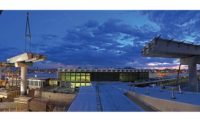... later this month. “For a roof that looks like a Pringles potato chip, it really went together,” says Ken Johnson, vice president of Hunt Construction Group, which holds a construction management contract in a joint venture with another local firm, Smoot Construction Co.
The tricky truss, isolated to one corner of the terminal, forced workers to redouble their efforts on building out the concourses, which now are ahead of schedule by about three months. Kish thinks the work eventually will balance out for an on-time completion. Cost control and coordination saved major delays.
 Tudor Hampton/ENR Giant rotunda skylight goes in this summer.
|
But the midfield terminal is still labor intensive. “It’s a lot of welding and a lot of grinding,” says Johnson. Although the quality of weld finishes at roof level was toned down to save costs, down at the floor level “that truly is lot of plain labor to make that happen,” says Hanenburg. Fitting up the structural framing to prevent future skylight leaks also is a big focus for the contractors, says Johnson.
At departure level, four-pronged tree columns supporting the trusses, which hang 60 to 80-ft high, are tubular members that taper in diameter from 24 in. to 13 in. across 8-ft-long conical sections and get pinned at the top and bottom. The pins minimize weight because they eliminate the need for moment connections, but the savings are offset by the finishing labor. The tubes, eyes, and receiver armatures are all welded together and ground smooth before painting.
In carrying out the terminal design, which was delayed for 18 months as the owner and the airlines worked out the wrinkles in the program after 9/11, the budget ballooned from $808 million, mostly due to inflation and federal requirements for inline baggage screening. Then, in 2004, when steel prices rocked the construction industry, the owner and its consultants started to worry about overruns. The terminal roof and column design, which calls for pins to go in last, also required that trusses get jacked into the air, limiting methods.
Request for proposals for the terminal’s high roof went out twice, with the owner later opting to absorb the incremental materials cost from bid date to mill order. That changed bids from $10 million over estimate to only $3 million over. “Risk equates to cost,” says Kish. “It was better for us to bear that risk than to pay the contractor to bear it.” In the end, price escalation had little effect. Total structural steel in the building, including the concourses, came to 11,000 tons.
For the concourses, which were originally designed as structural steel throughout, Johnson recommended to Kish that IAA prepare an alternate design, one with cast-in-place concrete on the lower floor, which is part of airside operations. “It saved us from guessing wrong,” says Kish. Although concrete costs had started to rise, the alternate composite bid was selected, saving the owner more than $1 million, though that is just a rough estimate. “You don’t know how much you actually saved,” says Johnson. Much value engineering prevented “death by a thousand cuts,” he says.
While it was touching up its terminal design, IAA moved forward on site construction by starting mass grading for a 7,100-car parking garage, 340-ft-tall control tower and road work approaching the site. A subcontractor team led by construction manager Turner Construction, New York City, and locally based Trotter Construction Co. Inc. also bored an 8-ft-diameter, 2,000-ft-long tunnel under the airfield’s north parallel runway. The tunnel, which will be grouted, is filled with utilities linking the new terminal to an existing energy plant 5,800 ft away that United Air Lines abandoned after it went bankrupt in 2002. Tying in the plant saved more than $10 million and also will save “significant” operating costs, Kish says.
IAA also saved by spreading work among 189 contractors and 124 bids to obtain local labor, share risks and control costs. “We all have what we call skin in the game,” says Johnson. The CMs receive a flat fee plus incentives and coordinate the trades, but the builders hold contracts directly with the owner.
Greener Pastures
IAA plans to apply for basic-level certification from the U.S. Green Building Council and may reach “silver” designation. Initially, the owner hesitated to pursue a USGBC rating for fear that costs would shoot through the roof. But it only added $200,000 to $300,000 upfront, according to HOK. The owner had already set out to build green, with “low-e” glass, local and recycled materials, two-tier glycol recovery, products low in volatile organic compounds, among other things.
The local program manager, Aviation Capital Management, thinks the new airport will be the first to achieve USGBC certification beyond its terminal building. Its footprint comprises the central terminal, roads, concourses and parking, says Richard V. Potosnak, president of ACM.
When planes start rolling into the midfield terminal, the savings are expected to add up quickly. “When we started this back in 2000, our estimates were that airlines would save $6 million in fuel for rolling the airplanes along the ground,” says Kish. The fuel savings today, he says, “are probably up to $12 million. We think it’s a win for everybody.”

